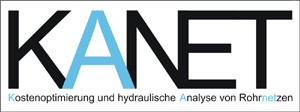KANET
Simulation & optimization of water supply networks. From the University of Karlsruhe web site:
KANET Simulation
KANET Simulation performs the time extended hydraulic network balance of a reticulate system whose graph, diameters, pipe material or friction factors, flow input and demand, characteristics of pumps, boosters, valves, location of tanks, pumping stations, valves are known. The model also allows for tracing the propagation of an input concentration.
KANET Optimization
KANET Optimization delivers cost optimal diameters and pumping heads of a reticulate water supply network based upon a specified design demand and subject to constraints such as max velocities, min supply pressure, location of pumps, tanks and reservoirs. Already existing pipes are taken into account, optimal tradeoffs between investment and operating cost are observed using the present value. Simultaneous optimization of the layout is included.

KANET Simulation & Optimization
KANET Optimization and Simulation may be employed independently or with mutual reference, e.g. if the operation of an existing design is to be verified by simulation, or if a new design derived for peak load by optimization is to be operated under different load or control conditions, etc.
Algorithms used in the optimization:
1. Graph Theory – Decomposition of the reticulate system
2. Linear Programming (LP) – Optimization of branch networks
3. Genetic Algorithms – Optimization of layout and of reticulate system
KANET Database & Viewer
The KANET Access database provides a graphical user interface (GUI) designed to guide the userג€™s data input and data editing, data transfer from optimization to simulation or vice versa, also permitting data visualization by calling a Viewer. The KANET Viewer visualizes details of the network employing different colors or widths of lines and bars to show the size of diameters or of hydraulic parameters, depicting the time extended behavior of pressure, of flows or water quality, using diagrams, tables and charts facilitating the analysis. Interfaces to AutoCad, GIS ArcView and EPANET are available.
For more information see the KANET web site
Leave a Reply